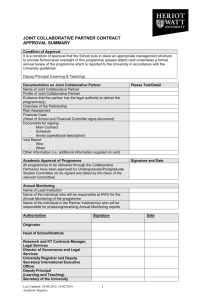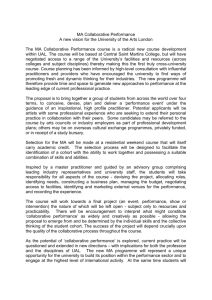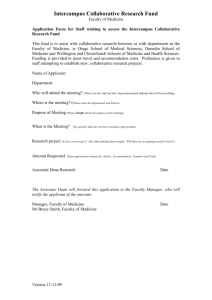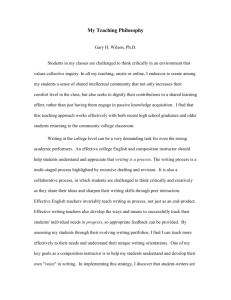Utilizing Games to Enhance Collaborative Learning
advertisement
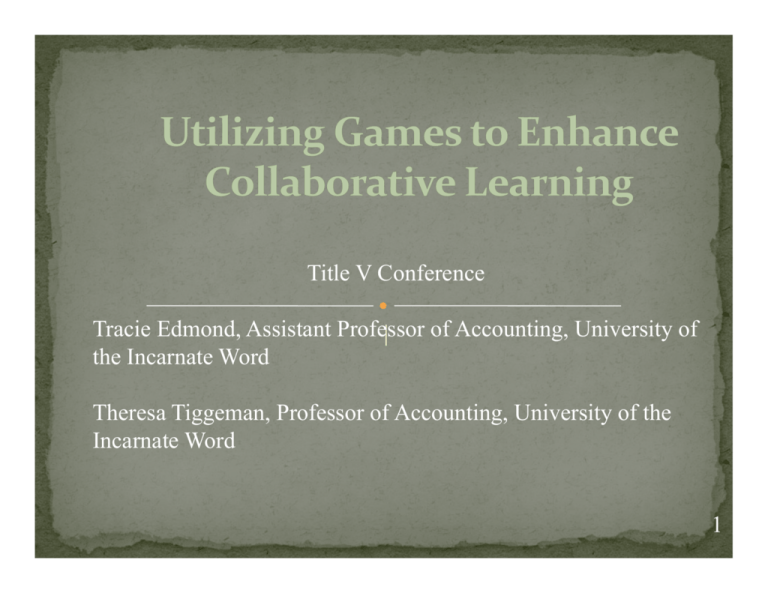
Title V Conference Tracie Edmond Edmond, Assistant Professor of Accounting Accounting, University of | the Incarnate Word Theresa Tiggeman, Th Ti Professor P f off Accounting, A ti University U i it off the th Incarnate Word 1 Utilizing Games to Enhance Collaborative g Learning Introduction Topic Bingo Who Wants to Be A Millionaire Hollywood Squares Jeopardy 2 y Rules y The topics covered in today’s lecture are on the group BINGO cards y As the topic is mentioned mark it off your card and lists any corresponding notes on the topic at the bottom of the card y One you get three in a row, either diagonally, vertically or horizontally yell out BINGO What is Collaborative Learning? g 4 Questions About Groups Paradigm Shift g Accounting Education Change Commission’s Pronouncement 5 Key Areas Emphasized in the Pronouncements › Student as Active Participant › Students Learn to Solve Unstructured Problems › Students Learn by Doing › Students Learn to Work Well in Groups p › Students Learn Creative Uses Of Technology The student should be an active participant in the learning process The student should be taught to identify and solve unstructured problems that require use of multiple d bl h i f l i l information sources The student should learn by doing The student should learn to work in groups The students should be taught the creative use of technology (Saunders & Christopher, 2003) American Institutes of Certified Public Accountants The AICPA has seven elements in its personal competencies that should b b i d b be obtained by anyone entering the accounting professor as a CPA i h i f CPA 1. 2. 3. 4. 5. 6. 7. Professional Demeanor Problem Solving and Decision Making Interaction L d hi Leadership Communication P j M Project Management Leverage Technology 15.1% require an accounting lab g 54.3% require the use of computers in completing assignments 20% require simulations 60% require a team‐learning approach or 6 % i l i h collaborative learning (Saunders & Christopher, 2003). Collaborative learning leads to inefficient allocation of student time and that the inefficiency in time allocation may reduce student knowledge Proper allocation of grades, because in team assignments, Proper allocation of grades because in team assignments the same grade is usually given to the group Faculty time y Many students feel negatively about sharing grades, resent students who tag along for the ride or feel uncomfortable with the diffusion of responsibility Many businesses rely on teamwork to get any job g j done Faculty time is increased in learning any new pedagogy Actual employment situations incorporate the negative aspects of collaborative learning Student understanding increases Interactive Example: Who Wants to Be A Millionaire 4/20/2009 Each table is a group If you do not know the answer you have 3 lifelines • 4/20/2009 Life Lines 1. 2. 3. • Ask another group for help Poll the class or the group Ask the instructor for a 50/50 Question: Wh i h b i f ll b What is the best size for a collaborative learning i l i group? • A. B. C C. D. 10 – 12 1‐2 50 100 50‐100 4‐6 Question: Wh i h b i f ll b What is the best size for a collaborative learning i l i group? • A. B. C. D. 1‐2 4‐6 Jeopardy as a Review or Summary Tool y Di id h d Divide the students into groups i y Each group is to develop the categories and the review questions and answers q y Once the students come up with their categories, then each member of the group is responsible for coming up with at least one p g p review question in each category • Then review day becomes game day as the students play each groups board. students play each groups board If there is a debate on the answers, each student can plead their case to the judge ( the professor) or the professor can approve f ) th f questions and answers ahead of time. • y Who Wants to Be A Millionaire Who Wants to be a Millionaire.ppt Hollywood Squares y Hollywood Squares Template.ppt Jeopardy y Jeopardy1Template.ppt y Conclusion y Question and Answer y Fiechtner, S. B., and Davis, E. A. (1992). "Why some groups fail: A survey of students' experiences with learning fail: A survey of students experiences with learning groups". In Goodsell, A. S., Maher, M. R., and Tinto, V. (Eds.), Collaborative Learning: A Sourcebook for Higher Education. National Center on Postsecondary Teaching, Learning, & Assessment, Syracuse University. y Johnson, D. W., Johnson, R. T., and Smith, K. A. (1998). Johnson D W Johnson R T and Smith K A (1998) Active learning: Cooperation in the college classroom. Edina, MN: Interaction Book Company

